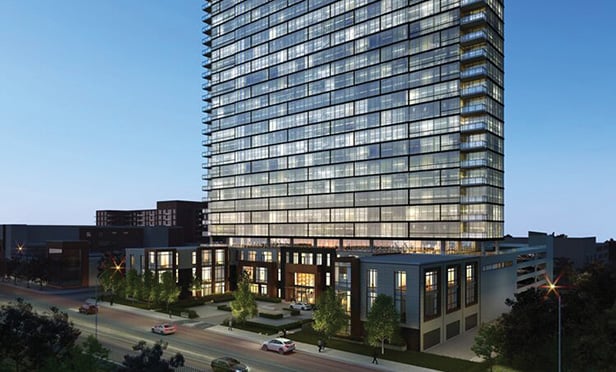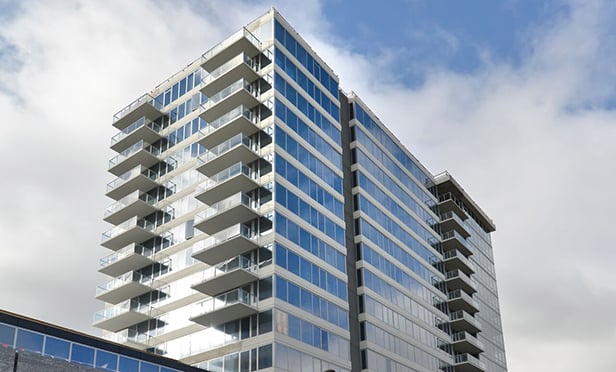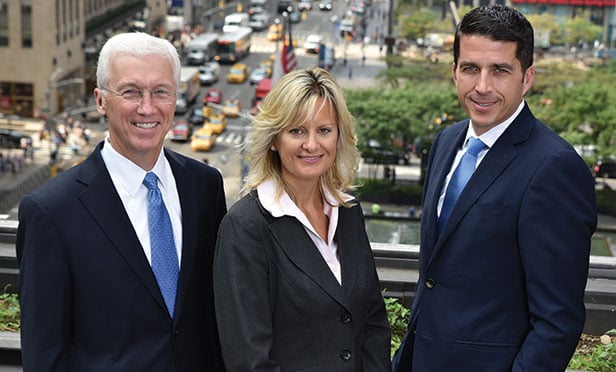
This is an HTML version of an article that ran in Real Estate Forum. To see the story in its original format, click here.
It's been a truism for some time that renting is a young person's game—or, more properly, preferred mode of living. And while twenty-somethings move out of their parents' houses and into apartments, the parents eventually face empty nest syndrome, downsize out of those homes and move into retirement communities in warmer climes. At least, that's how the conventional wisdom has imagined the sequence of events over the years.
However, the conventional wisdom has since given way to the realization that both Millennials and Baby Boomers are participants in the “new urbanism” identified as one of the mega-trends shaping commercial real estate. “The aging of the Baby Boomers, the arrival of the Millennials in the workforce and the increasing preference of both to combine a 'live, work, play' lifestyle in a compact city center are reshaping the real estate market,” according to law firm Akerman's 2015 Real Estate Industry Outlook Report.
And while that doesn't doom to obsolescence all the multifamily product geared specifically toward younger renters in recent years, it does make the case for developing product that can accommodate both generations' preferences. “Clearly, well-located urban apartments have drawn strong demand from Millennials, but demand is showing up from other demographic groups as well, notably Boomers and empty nesters,” Jim Andersen, a senior vice president with Trammell Crow Co.'s High Street Residential division, tells Real Estate Forum. “Some of the same features thought to be directed toward Millennials, such as larger, informal WiFi-enabled gathering spaces, have also become very popular to the Boomer demographic.”
That being the case, it's also true that, as National Development's Andrew Gallinaro puts it, “Millennials really drove that change in perspective” toward urbanism. Tying together National Development's Boston-area residential and mixed-use projects are elements with appeal to multiple generations: good location, convenient access and a highly walkable environment.
In another Millennial-driven consideration that Boomers also welcome, “We've taken care to focus on an environment of wellness,” says Gallinaro, SVP of asset and property management at Newton Lower Falls, MA-based National Development. At the company's newly opened Ink Block residential and retail complex—which served as a catalyst for the redevelopment of a South End street that the Boston Globe recently characterized as “scruffy”—Capital One sponsored shrink@INK, a 10-week series of classes led by two of Boston's best-known fitness gurus. Millennials and Boomers alike who work at ND's The District, a 1.3-million-square-foot office and retail complex in suburban Burlington, have easy access to an on-site fitness studio, walkable open space, a Pure Barre location and a Lahey Health facility.
Developers' recognition that Millennials and Boomers often want the same things is a relatively recent phenomenon. “We've been actively building apartments for over a decade, and when we started, we built primarily for ages 22 to 25,” Randy Fifield, vice chair of Fifield Cos., tells Forum. “Then we saw these parents coming in and they just loved being able to have everything at their fingertips and one check to write.” She notes that when Fifield readied its E2 luxury rental complex in the Chicago suburb of Evanston, IL, “there was a waiting list to get in, and the median age of the first 40 people was close to 40 years old.”

Jim Crews, who co-heads Cushman & Wakefield's Southwest multifamily advisory group from offices in Phoenix, thinks that Millennials and Boomers come to the same place, but for different reasons. “With Baby Boomers, there are a lot of empty nesters who are looking to downsize,” he says. “They may or may not have lost their housing to foreclosure, and people who can buy a home but think that a lock-and-leave apartment situation is not a bad idea. You've got some who are using the luxury apartment concept as second homes, which is a new phenomenon here but we're seeing it. Then on the Millennial side, they either don't want to buy a home or can't buy a home. What happens is that they all end up being commingled in this one 300-unit class A apartment building in Scottsdale.”
Many empty nesters, now contemplating retirement and thinking about to stretch a dollar, have come to understand that condominium ownership means writing three checks. “It's a mortgage, it's an assessment and it's a tax bill,” says Fifield. “That's daunting when you're on a limited or fixed income at 68 years old.”
Andersen points out another feature of apartment living that appeals to both age cohorts: “Both groups are weary of driving and have discovered the flexibility of being proximate to public transportation,” he says. “Both groups enjoy leaving their apartment and dining or performing daily tasks within walking distance. Further, ground floor retail is not only a beneficial mix of uses for the project, but often an identifying landmark for the building.”
With the mix of Millennials and Boomers comes a wider spread of household incomes at the same property, points out Eugene Diaz, principal with Prism Capital Partners in Bloomfield, NJ. “In general, because the demand is increasing from a variety of cohorts, providing broad-based amenities and much more luxury-oriented finishes is becoming more important to make certain that you appeal to the socioeconomic status of a variety of those cohorts,” Diaz tells Forum. “Where previously within a building the incomes would have been within a band of $30,000 to $40,000 of one another, now you're seeing a range of income of hundreds of thousands of dollars between people in the same building. It tells you that people who can afford to own are not necessarily doing so.”

At Chicago-based JDL Development, EVP and CIO Yale Dieckmann similarly advocates a broad-based approach to amenities when appealing to both Millennials and their parents' generation. “It's not about creating spaces that are so specific to one or the other,” he says. “It's about creating amenities that are appealing to as broad a population as possible and have the most flexible applications, the most flexible use.”
He cites an on-premises BYOB tap pub at 1000 South Clark, a luxury high-rise that JDL opened this year in Chicago's South Loop. “Would a 26-year-old Millennial want to use it for a Super Bowl party? Sure,” Dieckmann says. “Would a Baby Boomer want to use it for a board meeting of a charitable organization they sit on? Yes. Those types of spaces are perfectly suited for both those types of uses.”
Although no one feature of a development is the deciding factor as far as Boomer appeal is concerned, Diaz notes that “the focal point of a significant portion of that renter cohort is safety and security. As you move from private residential housing, with its alarm systems and the like, and you move into a multi-tenanted building in some downtown area, making certain that the building is adequately secure is certainly on everybody's checklist.”
Another draw, says Diaz, is “unique product.” Prism is putting that principle into action with Edison Village, an MXD in suburban West Orange, NJ built around the long-disused Edison Storage Battery factory opposite Thomas Edison National Historic Park. “Bigger windows, higher ceilings, concrete construction,” he says. “There's a different feeling when you walk into a building that's made of concrete compared to one that's made of timber.”
A recent New York Times article on the Edison Village project quoted the township's mayor, Robert D. Parisi, as predicting that the project would appeal mainly to “young professionals and empty nesters.” Diaz similarly tells Forum that “you're likely to see a wider mix of demographics” in such a project compared to the renter cohort in, say, Harrison, NJ, an industrial area that's also undergoing extensive redevelopment.
For Boomers moving from the suburbs, downsizing into an apartment once would have meant putting the family dog up for adoption. “In the past, dogs may not have been as welcome, especially not in luxury rentals,” says Stephen Santola, EVP and general counsel for Woodmont Properties in Fairfield, NJ. No longer: today, pet-friendly facilities are part of a menu of amenities at projects such as Woodmont Station in Cranford, a New Jersey suburb with easy rail access to New York City.

JDL also incorporates dog-friendly spaces into all of its residential projects. “In the case of 1000 South Clark, where we have an abundance of interior space, we put in a full-service third-party pet care facility,” says Dieckmann. “In other projects where we don't have the space to do that inside, we will always at a minimum do an outdoor dog run, because that's another amenity that spans generations. Boomers have pets and have had them their whole lives. At the other end, Millennials are spurred into maybe getting a pet sooner because it is so convenient to have that play and space option.”
Even as developers realize the crossover potential of reaching both Millennials and Boomers, Santola tells Forum the industry is still figuring out what Millennials want. “There certainly seems to be a delay in family formation, less of a desire to own a single-family home,” he says. “It's not that there isn't a certain percentage of Millennials who want to do those things or will do them on a timeline that an older generation isn't used to. But there are so many of them that if 50% don't see themselves buying a single-family home, then that's a huge market. And understanding that market, because it's just emerging, is important for all of us.”
One area in which this evolving awareness manifests itself is changes and tweaks to a developer's amenities package. “One amenity we're getting into now is rooftop amenity stations, party decks,” says Santola. “We're finding that people will just head up there on a Friday night, without necessarily having plans, just a bottle of wine. So it becomes a meeting place and a jumping-off place for another social experience. But those types of amenities continue to evolve and, as the Millennials move further into the real estate market and become an increasingly dominant force, I think we'll have a better understanding of what it is that they're really drawn to.”

This is an HTML version of an article that ran in Real Estate Forum. To see the story in its original format, click here.
It's been a truism for some time that renting is a young person's game—or, more properly, preferred mode of living. And while twenty-somethings move out of their parents' houses and into apartments, the parents eventually face empty nest syndrome, downsize out of those homes and move into retirement communities in warmer climes. At least, that's how the conventional wisdom has imagined the sequence of events over the years.
However, the conventional wisdom has since given way to the realization that both Millennials and Baby Boomers are participants in the “new urbanism” identified as one of the mega-trends shaping commercial real estate. “The aging of the Baby Boomers, the arrival of the Millennials in the workforce and the increasing preference of both to combine a 'live, work, play' lifestyle in a compact city center are reshaping the real estate market,” according to law firm Akerman's 2015 Real Estate Industry Outlook Report.
And while that doesn't doom to obsolescence all the multifamily product geared specifically toward younger renters in recent years, it does make the case for developing product that can accommodate both generations' preferences. “Clearly, well-located urban apartments have drawn strong demand from Millennials, but demand is showing up from other demographic groups as well, notably Boomers and empty nesters,” Jim Andersen, a senior vice president with Trammell Crow Co.'s High Street Residential division, tells Real Estate Forum. “Some of the same features thought to be directed toward Millennials, such as larger, informal WiFi-enabled gathering spaces, have also become very popular to the Boomer demographic.”
That being the case, it's also true that, as National Development's Andrew Gallinaro puts it, “Millennials really drove that change in perspective” toward urbanism. Tying together National Development's Boston-area residential and mixed-use projects are elements with appeal to multiple generations: good location, convenient access and a highly walkable environment.
In another Millennial-driven consideration that Boomers also welcome, “We've taken care to focus on an environment of wellness,” says Gallinaro, SVP of asset and property management at Newton Lower Falls, MA-based National Development. At the company's newly opened Ink Block residential and retail complex—which served as a catalyst for the redevelopment of a South End street that the Boston Globe recently characterized as “scruffy”—
Developers' recognition that Millennials and Boomers often want the same things is a relatively recent phenomenon. “We've been actively building apartments for over a decade, and when we started, we built primarily for ages 22 to 25,” Randy Fifield, vice chair of Fifield Cos., tells Forum. “Then we saw these parents coming in and they just loved being able to have everything at their fingertips and one check to write.” She notes that when Fifield readied its E2 luxury rental complex in the Chicago suburb of Evanston, IL, “there was a waiting list to get in, and the median age of the first 40 people was close to 40 years old.”

Jim Crews, who co-heads Cushman & Wakefield's Southwest multifamily advisory group from offices in Phoenix, thinks that Millennials and Boomers come to the same place, but for different reasons. “With Baby Boomers, there are a lot of empty nesters who are looking to downsize,” he says. “They may or may not have lost their housing to foreclosure, and people who can buy a home but think that a lock-and-leave apartment situation is not a bad idea. You've got some who are using the luxury apartment concept as second homes, which is a new phenomenon here but we're seeing it. Then on the Millennial side, they either don't want to buy a home or can't buy a home. What happens is that they all end up being commingled in this one 300-unit class A apartment building in Scottsdale.”
Many empty nesters, now contemplating retirement and thinking about to stretch a dollar, have come to understand that condominium ownership means writing three checks. “It's a mortgage, it's an assessment and it's a tax bill,” says Fifield. “That's daunting when you're on a limited or fixed income at 68 years old.”
Andersen points out another feature of apartment living that appeals to both age cohorts: “Both groups are weary of driving and have discovered the flexibility of being proximate to public transportation,” he says. “Both groups enjoy leaving their apartment and dining or performing daily tasks within walking distance. Further, ground floor retail is not only a beneficial mix of uses for the project, but often an identifying landmark for the building.”
With the mix of Millennials and Boomers comes a wider spread of household incomes at the same property, points out Eugene Diaz, principal with Prism Capital Partners in Bloomfield, NJ. “In general, because the demand is increasing from a variety of cohorts, providing broad-based amenities and much more luxury-oriented finishes is becoming more important to make certain that you appeal to the socioeconomic status of a variety of those cohorts,” Diaz tells Forum. “Where previously within a building the incomes would have been within a band of $30,000 to $40,000 of one another, now you're seeing a range of income of hundreds of thousands of dollars between people in the same building. It tells you that people who can afford to own are not necessarily doing so.”

At Chicago-based JDL Development, EVP and CIO Yale Dieckmann similarly advocates a broad-based approach to amenities when appealing to both Millennials and their parents' generation. “It's not about creating spaces that are so specific to one or the other,” he says. “It's about creating amenities that are appealing to as broad a population as possible and have the most flexible applications, the most flexible use.”
He cites an on-premises BYOB tap pub at 1000 South Clark, a luxury high-rise that JDL opened this year in Chicago's South Loop. “Would a 26-year-old Millennial want to use it for a Super Bowl party? Sure,” Dieckmann says. “Would a Baby Boomer want to use it for a board meeting of a charitable organization they sit on? Yes. Those types of spaces are perfectly suited for both those types of uses.”
Although no one feature of a development is the deciding factor as far as Boomer appeal is concerned, Diaz notes that “the focal point of a significant portion of that renter cohort is safety and security. As you move from private residential housing, with its alarm systems and the like, and you move into a multi-tenanted building in some downtown area, making certain that the building is adequately secure is certainly on everybody's checklist.”
Another draw, says Diaz, is “unique product.” Prism is putting that principle into action with Edison Village, an MXD in suburban West Orange, NJ built around the long-disused Edison Storage Battery factory opposite Thomas Edison National Historic Park. “Bigger windows, higher ceilings, concrete construction,” he says. “There's a different feeling when you walk into a building that's made of concrete compared to one that's made of timber.”
A recent
For Boomers moving from the suburbs, downsizing into an apartment once would have meant putting the family dog up for adoption. “In the past, dogs may not have been as welcome, especially not in luxury rentals,” says Stephen Santola, EVP and general counsel for Woodmont Properties in Fairfield, NJ. No longer: today, pet-friendly facilities are part of a menu of amenities at projects such as Woodmont Station in Cranford, a New Jersey suburb with easy rail access to

JDL also incorporates dog-friendly spaces into all of its residential projects. “In the case of 1000 South Clark, where we have an abundance of interior space, we put in a full-service third-party pet care facility,” says Dieckmann. “In other projects where we don't have the space to do that inside, we will always at a minimum do an outdoor dog run, because that's another amenity that spans generations. Boomers have pets and have had them their whole lives. At the other end, Millennials are spurred into maybe getting a pet sooner because it is so convenient to have that play and space option.”
Even as developers realize the crossover potential of reaching both Millennials and Boomers, Santola tells Forum the industry is still figuring out what Millennials want. “There certainly seems to be a delay in family formation, less of a desire to own a single-family home,” he says. “It's not that there isn't a certain percentage of Millennials who want to do those things or will do them on a timeline that an older generation isn't used to. But there are so many of them that if 50% don't see themselves buying a single-family home, then that's a huge market. And understanding that market, because it's just emerging, is important for all of us.”
One area in which this evolving awareness manifests itself is changes and tweaks to a developer's amenities package. “One amenity we're getting into now is rooftop amenity stations, party decks,” says Santola. “We're finding that people will just head up there on a Friday night, without necessarily having plans, just a bottle of wine. So it becomes a meeting place and a jumping-off place for another social experience. But those types of amenities continue to evolve and, as the Millennials move further into the real estate market and become an increasingly dominant force, I think we'll have a better understanding of what it is that they're really drawn to.”
© Touchpoint Markets, All Rights Reserved. Request academic re-use from www.copyright.com. All other uses, submit a request to [email protected]. For more inforrmation visit Asset & Logo Licensing.








